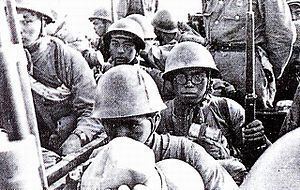350,000 men 1 Army (Corps) Result Chinese victory | Dates 1 May 1940 – 18 Jun 1940 | |
 | ||
Over 60,000 killed and wounded81 artillery pieces, 727 automatic weapons, 12,557 rifles captured 2,700 killed7,800 wounded Similar Second Sino‑Japanese War, Battle of Suixian–Zaoyang, Battle of Wuhan, Battle of Xuzhou, Battle of Shanggao | ||
Battle of zaoyang yichang
The Battle of Zaoyang–Yichang (simplified Chinese: 枣宜会战; traditional Chinese: 棗宜會戰; pinyin: Zǎoyí Huìzhàn), also known as the Battle of Zaoyi, was one of the 22 major engagements between the National Revolutionary Army and Imperial Japanese Army during the Second Sino-Japanese War.
Contents
Background
The Japanese were seeking a quicker solution to achieve a Chinese surrender. The Japanese contemplated moving directly down the Yangtze to the relocated Chinese capital, Chongqing. To do so, they would need to capture a critical town in western Hubei province, Yichang.
The Japanese attack did not commit many troops or materiel, which enabled the main Chinese commander, Li Zongren, who had frustrated the Japanese before, to repel the Japanese.
Battle
On first May, the Japanese forces began a drive towards Zaoyang. They pushed towards the 5th warzone's strongholds in the Tongbaishan and Dahongshan mountains, attempting to draw the Chinese forces into a battle and destroy them with a pincer movement. The Chinese strategy aimed to let the Japanese forces run low on supplies, and then destroy them.
Aftermath
The Japanese casualties were 2,700 troops killed and 7,800 wounded. The occupation of Ichang gave the Japanese an advantageous base for air attacks against Chongqing. Furthermore, it dealt a considerable blow to the morale and fighting capacity of the Chinese as no large-scale offensive was mounted after this operation.
